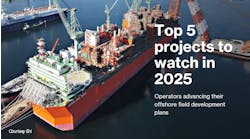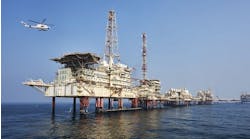Mike Major
Energy Industries Council
The offshore oil and gas sector has faced something of a rollercoaster ride over the last few years.
While the financial crisis and credit crunch resulted in a number of offshore projects being put on hold, there are some positive signs that a full recovery is underway – helped, of course, by the soaring oil prices.
TheEIC Monitor, our quarterly report that tracks over 8,500 active and future projects in the global energy industry through the EICDataStream database, found that the last quarter of 2010 saw 74 new projects in the upstream oil and gas sector totalling $41.16 billion – a 54% increase in the number of new projects from the previous quarter.
In the offshore oil and gas sector in particular, a significant number of current projects are to be found. By project value, the Caspian region leads in terms of dollar amount, followed again by Europe.
And more offshore investment is likely to follow in Europe as well. Oil & Gas UK, the trade association for the UK offshore oil and gas sector, believes that up to 25 Bbbl remain to be won from the UK continental shelf alone, and in June 2010 UK Energy Minister Charles Hendry revealed bids for 356 blocks in the 26th licensing round for offshore exploration, the largest number since the first licensing round in 1964.
Total value for offshore projects by regions of the world.
Why are the UK and Europe such a focus of offshore investment? Apart from the evident investment potential of many of these fields particularly for smaller players, one reason is the sophisticated supply chain and leading technologies UK companies bring to the offshore sector both in Europe and across the world.
From the need to produce from ever deeper, more remote, and geologically complex fields through to the need to make smaller brown field sites economically viable and increase returns from larger existing fields, operators need to deliver genuine economic value from their assets and they need to do it now.
Technology is the great enabler, with UK companies more often than not setting the standards. Today, annual turnover in the UK oil and gas supply chain is almost £16 billion ($26 billion), according to Oil & Gas UK, with two thirds of this due to domestic sales and one third exports. The UK oil and gas sector and supply chain employs 450,000 people and includes more than 10,000 companies.
The EIC believes its more than 600 members, comprising contractors and suppliers from all areas of the energy sector but many in the offshore oil and gas sector, employ in aggregate around 1 million people and generate £100 billion ($160 billion) in revenues from UK operations.
From major oilfield, logistics, and engineering companies through to instrumentation and communications specialists, wire rope providers, petrochemical and electrical suppliers, water treatment solution providers, pipeline technology specialists, and enhanced oil recovery specialists, UK companies show the latest in offshore technologies to meet the challenges of production optimization and reducing costs.
Yet, why are UK companies proving to be so successful in developing innovative offshore technologies? The key reason: the North Sea.
The North Sea, although having been in production for more than 40 years, remains one of the world’s most innovative offshore locations. Many of the regions challenges are being played out and solutions replicated in other fields globally.
Decades of exploration and development has created a highly sophisticated and advanced supply chain and UK technology companies that are becoming technology leaders the world over.
Subsea engineering
The growth in new players and focus on older and smaller fields can only be justified, if maximum use is made of both existing infrastructure and new technologies.
This requires an increased focus on reservoir monitoring technologies to ensure wells are performing at the optimum, intricate and complex offshore subsea developments, and a growth in technologies such as subsea tiebacks. Again, Europe leads the world in terms of number of subsea development projects.
And then perversely after mentioning all the recent bids for new developments in the North Sea, there is also the issue of decommissioning. Decommissioning the wide variety of structures in the North Sea (many of which were installed at different times to suit different field conditions) in deep and often inhospitable waters will be a monumental engineering and construction challenge for many UK offshore technology companies.
Reservoir instrumentation
Highly accurate and resilient reservoir instrumentation is also essential in the North Sea today – particularly due to the decline in profit margins and the need to ensure that equipment is working at its full potential.
Many of the North Sea’s fields also are defined by high pressures and temperatures and, due to the inhospitable conditions, long-term control systems are often the norm, with instruments having to be ultra-reliable while generating accurate, real-time data for decades.
The increased maturity of many North Sea fields also has generated growth in reinjection water to maintain pressures. This brings an attendant increased in the need for water to be treated in process facilities. Measurement tools that can monitor the separation process and provide detailed information on sand and oil in water are essential.
Other subsea challenges, such as protection against corrosion, hydrates, sand, and water breakthrough are also prevalent in the North Sea with deepwater wells and wet gas fields (there are a number of BP wet gas fields in the southern North Sea with a number also on the Norwegian continental shelf) all increasing the risk levels.
Such potential obstacles to production are being met through the latest in valve monitoring and actuation products, and inspection and corrosion consultancy services. Other solutions include well service, stimulation, pressure pumping, and flow control products.
Pipeline technologies
Increased pipeline mileage is being added across the North Sea, primarily due to the use of the previously mentioned subsea tiebacks as means of making small fields more viable. On subsea pipeline projects across the world, Europe is only second to Asia.
Pipeline challenges in the North Sea, as with any deepwater developments, include everything from robustness to the need for regular inspection and specific requirements such as high thermal performance and intelligent pigging.
Finally, there is offshore safety where, despite acknowledgements that there is still room for improvement in recent reports, the North Sea continues to have an enviable track record – even when some of its fields are in extremely inhospitable environments.
With operators entering even more challenging deepwater areas in regions, such as offshore Brazil and West Africa, there is clearly much that can be learned from the UK.
A breadth of technologies
The UK brings a wide breadth of offshore technologies to the industry. In addition to those above, there are providers of workforce optimization software, recruitment specialists, quality control and quality assurance services, electrical suppliers, thermal energy recovery equipment, high-temperature insulation solutions, and a company involved in enhanced oil recovery and digital artificial gas lift.
At a time of declining field rates and complex and often remote reservoirs, it is more important than ever to nurture technology, embrace innovation, and look to companies that have an offshore track record when planning your offshore deployments across the world. UK offshore companies are continuing to rise to the challenge.
Offshore Articles Archives
View Oil and Gas Articles on PennEnergy.com





